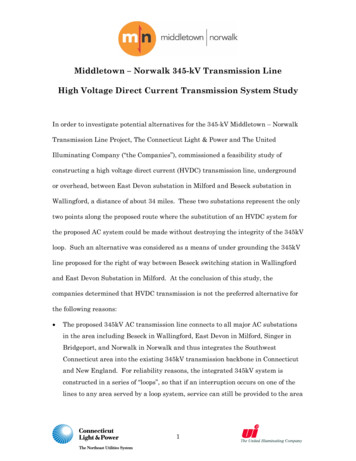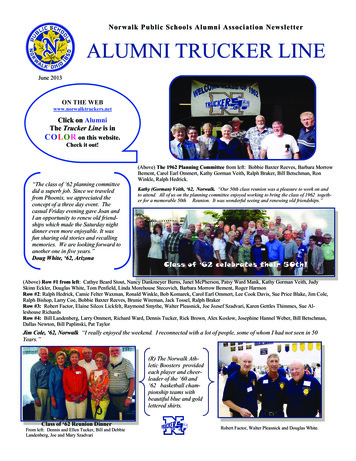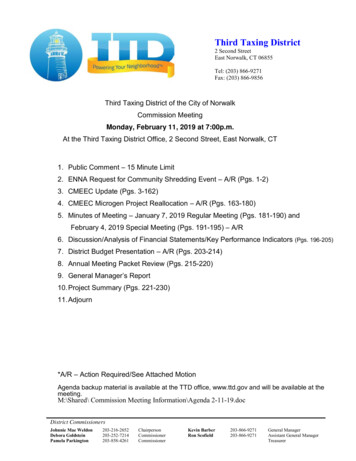
Transcription
Middletown – Norwalk 345-kV Transmission LineHigh Voltage Direct Current Transmission System StudyIn order to investigate potential alternatives for the 345-kV Middletown – NorwalkTransmission Line Project, The Connecticut Light & Power and The UnitedIlluminating Company (“the Companies”), commissioned a feasibility study ofconstructing a high voltage direct current (HVDC) transmission line, undergroundor overhead, between East Devon substation in Milford and Beseck substation inWallingford, a distance of about 34 miles. These two substations represent the onlytwo points along the proposed route where the substitution of an HVDC system forthe proposed AC system could be made without destroying the integrity of the 345kVloop. Such an alternative was considered as a means of under grounding the 345kVline proposed for the right of way between Beseck switching station in Wallingfordand East Devon Substation in Milford. At the conclusion of this study, thecompanies determined that HVDC transmission is not the preferred alternative forthe following reasons: The proposed 345kV AC transmission line connects to all major AC substationsin the area including Beseck in Wallingford, East Devon in Milford, Singer inBridgeport, and Norwalk in Norwalk and thus integrates the SouthwestConnecticut area into the existing 345kV transmission backbone in Connecticutand New England. For reliability reasons, the integrated 345kV system isconstructed in a series of “loops”, so that if an interruption occurs on one of thelines to any area served by a loop system, service can still be provided to the area1
from the other end of the loop. An HVDC transmission line, on the other hand,does not integrate Southwest Connecticut into the AC transmission grid in therest of Connecticut and New England. Unlike the ‘345kV Loop’, it does notprovide an instantaneous backup source for the loss of a portion of that loop. An HVDC transmission system isolates the load it serves from the rest of thegrid. It does not instantaneously pick up a portion of the load from an adjacentline that becomes deenergized. AC transmission lines, however, function as anintegrated circuit and will instantaneously pick up a share of the load of anycompanion line in the event that line is deenergized. Electric power transmission using HVDC technology is not economical for shortdistances such as the ones proposed in Southwest Connecticut (34 miles). HVDCtransmission systems need expensive converter stations at each end of thetransmission link to convert power from AC to DC and vice versa. Economicalconsiderations call for a certain minimum transmission distance (break-evendistance) before HVDC can be considered competitive, purely on cost. Estimatesfor the break-even distance between HVDC and AC transmission using overheadlines are around 300 miles. There is no break-even distance between theoverhead AC transmission and the underground HVDC transmission of electricpower. The direct cost for an HVDC link between Beseck and East Devon wouldbe approximately 564M for an underground option. The direct cost of theequivalent overhead AC facilities would be approximately 100M. Should theHVDC line be installed overhead, the direct cost would be approximately 400M,or 4 times as much as the equivalent AC facilities. The main reasons for thehigher costs are the need for converter stations at the terminals to convert ACinto DC and vice versa. Underground AC lines require reactive compensation and the ability to addreactive compensation must be considered when comparing underground options.HVDC only becomes viable when mid point reactive compensation is necessary2
on the AC line and cannot be added. Typically, this occurs on long (24 mile)submarine cables. AC/DC converters require a large amount of reactive power to operate correctly,both in rectification as well as in inversion. For a 1200 MW HVDC transmissionlink, reactors in the order of 480 MVAR to 660 MVAR (approximately 50% of theactive HVDC link) are needed. Synchronous or static capacitors have to beinstalled for this purpose. The need for these reactors increases the sizerequirements of the AC substation to which the converter station is connected. AC/DC converters generate many harmonics both on the DC side and on the ACside. Unless addressed, these currents can have many negative effects on thepower system, including but not limited to the malfunction of protection systemsand overheating of load elements such as induction motors, etc. The DCharmonics can also interfere with neighboring communication circuits. Filtershave to be installed on the AC side to mitigate the amount of harmonicstransferred to the AC system. On the DC side, smoothing reactors have to beinstalled. These components add to the cost of the converter. Unlike the AC transmission system, converters have very little overloadcapacity. They would have to be oversized to accommodate the same emergencyratings as an equivalent AC line. Approximately 15 acres of land for a converter station will be required at each ofthe terminal stations. This requirement is in addition to the land needed for theAC portion of the substations.Because of the above factors, the Companies determined that a high voltage DC(HVDC) transmission line is not a technically and economically practical option forthe Middletown to Norwalk project and eliminated this alternative from furtherconsideration.3
Middletown - Norwalk 345-kV Transmission Line High Voltage Direct Current Transmission System Study In order to investigate potential alternatives for the 345-kV Middletown - Norwalk . Electric power transmission using HVDC technology is not economical for short distances such as the ones proposed in Southwest Connecticut (34 miles). HVDC










